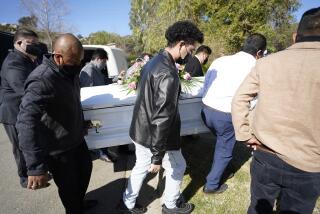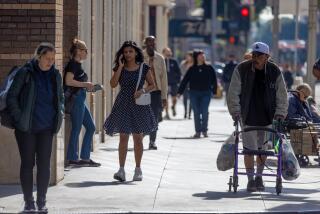Crisis in healthcare foreseen
The American medical system is woefully unprepared for the flood of aging baby boomers, according to a sweeping federal study released Monday, which predicted crisis-level shortages in healthcare workers and serious gaps in training.
The Institute of Medicine report -- âRetooling for an Aging America: Building the Health Care Workforceâ -- estimates that there currently is only one physician certified in geriatrics for every 2,500 older Americans and that turnover among nurseâs aides averages 71% annually.
In California, the situation is even more dire. Although the instituteâs study focused on the national picture, a state legislative report estimated that there is only one geriatrician for every 4,000 Californians age 65 and older.
In addition, only 3% of social work students specialize in gerontology, only 5% have taken a course on aging, and the state faces a shortfall of 30,000 certified nursing assistants who care for the frail elderly in convalescent homes, according to the California Strategic Plan on Aging Advisory Committee.
Although Californiaâs median age is one of the lowest in the country, according to the Census Bureau, there were nearly 4 million residents age 65 and older in 2006; that number is expected to more than double by 2030. Florida had just over 3 million residents 65 and older in 2006.
âJust at a time when we need more [geriatricians], weâre getting slightly fewer of them,â said John Pynoos, professor at USCâs Andrus Gerontology Center, who was not a part of the report released Monday. âThis is a crisis. . . . In California, weâre already behind the curve.â
Although older Americans will have less chronic disability and live longer than in the past, their numbers will be so great that they will swamp the healthcare system, the report said. In addition, they tend to have more complex conditions and healthcare needs than younger patients.
The first of the 78 million baby boomers will turn 65 in three years. By 2030, all will have hit that milestone, and the number of adults 65 and older will have almost doubled -- from 37 million in 2005.
The institute report said that there were 7,128 certified geriatricians today, and that the nation would need 36,000 by 2030. Optimistic estimates say the number of geriatricians will rise by only 10% in the next 22 years; others predict a net loss.
âThere will never be enough geriatricians,â said Dr. Joseph Scherger, a clinical professor of family and preventive medicine at UC San Diego, who served on the committee that researched and wrote the report.
âThe majority of the primary care of seniors is going to be done by general internists and family physicians,â Scherger said in an interview Monday. âHaving a good geriatric knowledge base and skills is critical.â
Among the reportâs recommendations: âThe geriatric competence of virtually all members of the healthcare workforce needs to be improvedâ through education and career-long assessment for physicians, social workers, nurses, nurseâs aides, physical therapists, home health aides and others.
California has among the stiffest requirements for nurseâs aides -- 150 hours of general training, said Susan Chapman, director of the Allied Health Workforce Program at UC San Francisco and a contributor to the report. But there are no training requirements for home care aides, Chapman said; in contrast, the state requires 350 hours of training for manicurists and 1,500 hours for hairstylists.
In addition to training, pay is another critical area for improvement, said Chapman, who is an assistant professor in the UCSF School of Nursing. The national average is $10.67 an hour for a nurseâs aide in a nursing home, Chapman said.
âMany of these workers live in poverty themselves, without benefits or health insurance,â she said. âTurnover can be up to 90% a year. That impacts on the quality of care, when we canât rely on a consistent person to care for your mother-in-law or my mother.â
Even doctors who specialize in geriatric medicine make less money than their counterparts in other medical fields, in part because a larger percentage of such specialistsâ income comes from Medicare and Medicaid, according to the report.
The institute called for âfinancial incentives to increase the number of geriatric specialists in all health professionsâ and recommended that states and the federal government institute programs to forgive education loans for those who care for older adults.
In fact, Assemblywoman Patty Berg (D-Eureka) introduced a state measure in February that would offer some loan forgiveness to physicians, nurses, social workers and marriage and family therapists who commit to three years of service in a geriatric setting.
The bill goes before the Assembly health committee today. Sen. Barbara Boxer (D-Calif.) introduced a similar measure at the federal level last month.
âWe have more people age 65 and older than any other state. Itâs not going to be very long before one in four is over 65,â Berg said. Recruiting, training and keeping enough workers to care for that population âis all about the money.â
--







